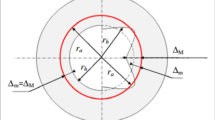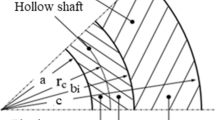Abstract
One of the greatest mechanical assembly techniques is shrink-fit assembly because of its superior economics. The axis and hub are all that are needed. It is employed in a wide range of sectors, including the manufacture of trains, automobiles, and aircraft. For this action, the inner diameter of the axis is greater than the outer diameter of the hub; this discrepancy is known as the “interference” between the two cylinders. This can be done in three different ways: the outside cylinder is heated to make it expand, through the inner cylinder’s cooling to make it contract, and third, by finishing the assembly under a press. From it produces contact pressure and frictional force at the point where the two matched components come together. Because they prohibit the connection between the axis and the hub from having a flawless form surface and because we will be examining how they affect the assembly, interference, and form defects are taken into consideration in this article. The distribution of stresses, assembly resistance, and plasticity are examined using numerical modeling to determine whether interference and form flaws have a positive or negative impact, where it was concluded that the form defect is necessary in the shrink-fit assembly.
















Similar content being viewed by others
Abbreviations
- σ r :
-
Radial stress
- σ t :
-
Tangential stress
- p i :
-
Internal pressure
- p o :
-
External pressure
- δ :
-
Interference
- E :
-
Young’s modulus
- E ′ :
-
Equivalent of Young’s modulus
- p nom :
-
Nominal pressure needed along the axial direction
- F ax :
-
Axial loading (force extraction)
- μ :
-
Friction coefficient
- a :
-
Radius inside the inner ring
- b :
-
Either the nominal inner radius of the outer ring or the nominal outer radius
- c :
-
Radius outside the outer ring
- A S :
-
Constant
- B S :
-
Constant
- C S :
-
Hollow shaft elasto-plastic radii
- R :
-
The asperity’s peak radius
- d :
-
Nominal diameter of the fit
- l :
-
Length of the fit
- N :
-
Amount of imperfections
References
Bedlaoui A, Boutoutaou H (2022) Effect of form defect on pipe surfaces subjected to pressure at the assembly point. Adv Mech Eng 14(7):1–8. https://doi.org/10.1177/16878132221109722
Bedlaoui A, Boutoutaou H (2023) Effect of form defect in thin-walled cylinder assembly. J Inst Eng (India): Series C:1–12. https://doi.org/10.1007/s40032-023-00946-9
Belghith S et al (2010) Modeling of contact between rough surfaces using homogenisation technique. Comptes Rendus - Mecanique 338(1):48–61. https://doi.org/10.1016/j.crme.2009.12.003
Bhetiwal A et al (2017) Effect of yield criterion on stress distribution and maximum safe pressure for an autofrettaged gun barrel. Defence Sci J 67(5):504–509. https://doi.org/10.14429/dsj.67.10636
Booker JD et al (2004) A comparison of shrink-fit holding torque using probabilistic, micromechanical and experimental approaches, Proceedings of the Institution of Mechanical Engineers. Part B: J Eng Manuf 218(2):175–187. https://doi.org/10.1243/095440504322886505
Boutoutaou H (2012) Etude d’un emmanchement fretté compte tenu de l’effet combiné des défauts de forme et d’état de surface.
Boutoutaou H, Bouaziz M, Fontaine JF (2011) Modeling of interference fits taking form defects of the surfaces in contact into account. Mater Design 32(7):3692–3701. https://doi.org/10.1016/j.matdes.2011.03.059
Chang WR, Bogy I, Etsion I (1986) An elastic-plastic model for the contact of rough surfaces. J Tribol 109:257–263
Croccolo D, De Agostinis M, Vincenzi N (2010) Static and dynamic strength evaluation of interference fit and adhesively bonded cylindrical joints. Int J AdhesAdhes 30(5):359–366. https://doi.org/10.1016/j.ijadhadh.2010.03.003
Croccolo D, De Agostinis M, Vincenzi N (2012) Normalization of the stress concentrations at the rounded edges of a shaft-hub interference fit: extension to the case of a hollow shaft. J Strain Anal Eng Design 47(3):131–139. https://doi.org/10.1177/0309324712439982
Fontaine JF, Siala IE (1998) Form defect influence on the shrinkage fit characteristics. Eur J Mech A/Solids 17(1):107–119. https://doi.org/10.1016/S0997-7538(98)80066-1
Gruescu C-M et al (n.d.) Interference fits. Bear Capacity Under Complex Loading-FEM Anal
Hüyük H et al (2014) Analysis of elastic-plastic interference-fit joints. Proc Eng 81:2030–2035. https://doi.org/10.1016/j.proeng.2014.10.276
Greenwood JA, Williamson JBP (1967) Contact of nominally flat surfaces. Proc Proc Roy Sot (London) 5(1442):1967
Kadin Y, Kligerman Y, Etsion I (2006) Unloading an elastic-plastic contact of rough surfaces. J Mech Phys Solids 54(12):2652–2674. https://doi.org/10.1016/j.jmps.2006.04.013
Kutuk MA et al (2003) Finite element analysis of a cylindrical approach for shrink-fit precision gear forging dies, Proceedings of the Institution of Mechanical Engineers. Part C: J Mech Eng Sci 217(6):677–686. https://doi.org/10.1243/095440603321919590
Laghzale N, Bouzid A (2016) Analytical modelling of elastic-plastic interference fit joints. Int Rev Model Simul 9(3):191–199. https://doi.org/10.15866/iremos.v9i3.8703
Martin F (2012) © Tous droits réservés, Francis Martin, 2012.
Maxim DI, Marsavina L, Rusu L (2018) The effect of manufacturing on the press fit insertion force. IOP Conf Series: Mater Sci Eng 416(1). https://doi.org/10.1088/1757-899X/416/1/012050
McCool JI (1986) Comparison of models for the contact of rough surfaces. Wear 107(1):37–60. https://doi.org/10.1016/0043-1648(86)90045-1
McMillan M et al (2018) Measurement of partial slip at the interface of a shrink fit assembly under axial load. Exp Mech 58(3):407–415. https://doi.org/10.1007/s11340-017-0359-y
Mouaa A, Laghzale NE, Bouzid AH (2021) Analytical modelling of interference fit joints with power law strain-hardening behavior. Int Rev Model Simul 14(1):24–31. https://doi.org/10.15866/iremos.v14i1.19126
Özel A et al (2005) Stress analysis of shrink-fitted joints for various fit forms via finite element method. Mater Design 26(4):281–289. https://doi.org/10.1016/j.matdes.2004.06.014
Öztürk F, Woo TC (2010) Simulations of interference and interfacial pressure for three disk shrink fit assembly. Gazi Univ J Sci 23(2):233–236
Qiu J, Zhou M (2016) Analytical solution for interference fit for multi-layer thick-walled cylinders and the application in crankshaft bearing design. Appl Sci (Switzerland) 6(6):13–16. https://doi.org/10.3390/app6060167
Robbe-Valloire F, Paffoni B, Progri R (2001) Load transmission by elastic, elasto-plastic or fully plastic deformation of rough interface asperities. Mech Mater 33(11):617–633. https://doi.org/10.1016/S0167-6636(01)00074-6
Siemiątkowski Z (2017) Experimental evaluation of the shrink-fitted joints in the assembled crankshafts. J Eng Technol 6(2):832–841
Stickel D, Wimmer MA, Fischer A (2013) Analyzing pin-on-ball wear tests by means of the Greenwood-Williamson contact model. Wear 301(1–2):4–10. https://doi.org/10.1016/j.wear.2012.12.056
Sun MY et al (2010) Three-dimensional finite element method simulation and optimization of shrink fitting process for a large marine crankshaft. Mater Design 31(9):4155–4164. https://doi.org/10.1016/j.matdes.2010.04.027
Timošenko SP (1957) Strength of materials. 2, Advanced theory and problems.
Truman CE, Booker JD (2007) Analysis of a shrink-fit failure on a gear hub/shaft assembly. Eng Fail Anal 14(4):557–572. https://doi.org/10.1016/j.engfailanal.2006.03.008
Wachsmuth G, Lätzer M, Leidich E (2014) Analytical computation of multiple interference fits under elasto-plastic deformations. ZAMM Zeitschrift fur Angewandte Mathematik und Mechanik 94(12):1058–1064. https://doi.org/10.1002/zamm.201300041
Xu Y et al (2019) Nanoscale measurements of the real area of contact and comparison to theoretical models, Electrical Contacts. Proc Annu Holm Conf Electrl Contacts 2019:156–163. https://doi.org/10.1109/HOLM.2019.8923698
Zhang Y, Mcclain B, Fang XD (2000) Design of interference fits via finite element method. Int J Mech Sci 42(1999):1835–1850
Zhao B, Zhang S, Keer LM (2017) Spherical elastic-plastic contact model for power-law hardening materials under combined normal and tangential loads. J Tribol 139(2):1–8. https://doi.org/10.1115/1.4033647
Zhao H (1997) Numerical analysis of the interference fitting stresses between wheel and shaft. Int J Mater Prod Technol 12(4–6):514–526
Zhao J et al (2019) Influence of radial interference on torque capacity of shrink-fit camshaft. Adv Mech Eng 11(4):1–10. https://doi.org/10.1177/1687814018817640
Author information
Authors and Affiliations
Contributions
The study’s inception and design involved input from all authors. Allal Bedlaoui and Hamid Boutoutaou prepared the material and carried out data gathering, analysis, and analysis. Allal Bedlaoui concept the manuscript’s initial draft, and all of the other authors offered feedback on earlier drafts. All authors have read and approved the final draft.
Corresponding author
Ethics declarations
Competing interests
The authors declare no competing interests.
Additional information
Publisher’s note
Springer Nature remains neutral with regard to jurisdictional claims in published maps and institutional affiliations.
Rights and permissions
Springer Nature or its licensor (e.g. a society or other partner) holds exclusive rights to this article under a publishing agreement with the author(s) or other rightsholder(s); author self-archiving of the accepted manuscript version of this article is solely governed by the terms of such publishing agreement and applicable law.
About this article
Cite this article
Bedlaoui, A., Boutoutaou, H. Effect of interference and form defect on the cohesion of the shrink-fit assembly. Int J Adv Manuf Technol 128, 2407–2418 (2023). https://doi.org/10.1007/s00170-023-12099-1
Received:
Accepted:
Published:
Issue Date:
DOI: https://doi.org/10.1007/s00170-023-12099-1




